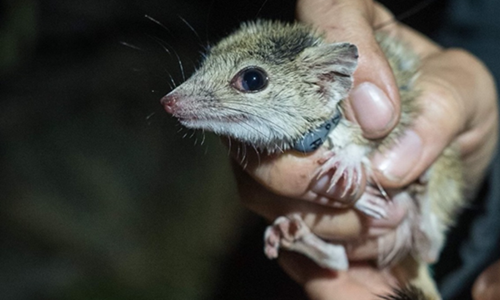
Facing extinction, a colony of tiny kowari have been found in a small pocket of north-eastern South Australia and some have been transferred to a refuge in the state’s outback.
Dr Katherine Tuft, the chief executive of not-for-profit gated animal reserve Arid Recovery, said they have been aware of the conservation needs of the kowari for some time and picked them as an animal that could benefit for protection from invasive animals.
Kowari, known by its Diyari name Kariri, is a nocturnal carnivorous marsupial that faces a 20 per cent risk of extinction in the next 20 years unless they are protected from key threats, such as feral cats.
“We started working on this in 2016 and it has been a big project working with the state government and researchers that have been assessing the risk to a whole lot of species in the area,” Dr Tuft said.
“In 2017 we were going to do a trial moving the kowaris but the drought hit at that point, so we put that on hold and in the last two years we were successful in getting a large commonwealth grant, so we started up again and it has been perfect timing.”
The Arid Recovery reserve on Andamooka Station covers 12,000 hectares and is fenced off to protect native species from foxes and feral cats.
Last week, 12 kowari were collected at Clifton Hills Station on the Birdsville Track – the last known population of the marsupial – and relocated to the safety of the reserve in hopes to breed up a sustainable population.
Dr Tuft said they managed to pack them into little transport crates full of straw so they would be cosy and then flew them in a light plane from the station directly to Arid Recovery.
She said it would take between five and 10 years to establish and then build up the population to a point where they could be harvested to repopulate areas outside the reserve.
“Hopefully the conditions will continue to be good for them to breed so that within a few years or so we can return some to the wild and potentially return them to places they were lost and re-establish the population,” Dr Tuft said.
The team will keep track of the well-being of the marsupials through continuous camera trap monitoring and radio tracking.
All going well, the researchers plan to collect more animals next year or in 2024.
Besides bolstering the total population, the translocation could also boost genetic variety, Dr Tuft said.
The Australian Government’s Environment Restoration Fund – Safe Havens program has provided funding for the reserve’s preparation to house the kowari and their translocation.
Arid Recovery also offers the chance to adopt a kowari or directly donate to purchase tracking equipment to help fund the conservation effort.
Words: Sabrina Scuteri | Photo: Ines Badman



